Kifara: description and difference from the lyre
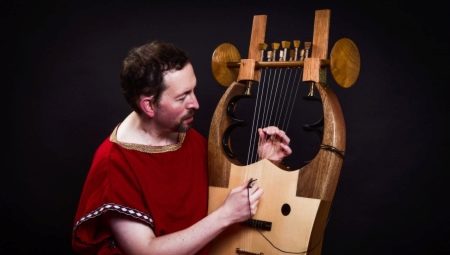
The stringed instrument, which is known as the kifara, is rightly considered one of the oldest, because its image can be found on many artifacts. In ancient times, musicians with kifara were minted on coins, painted in paintings and laid out on frescoes. Also, during excavations in old ancient Greek cities, many well-preserved fragments of amphorae were found, on which the outlines of a stringed musical instrument can be discerned. In this article, we will talk about how the cithara appeared and how it has evolved today.

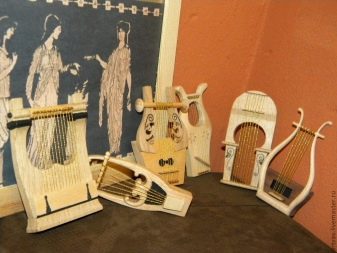
History of appearance
There is an ancient Greek legend that once upon a time a god named Hermes assembled a cithara using a tortoise shell, ox horns and several sinews as strings. The carapace served as the basis of the structure, the horns framed it and held the upper crossbar, the thin bovine tendons became strings. To obtain raw materials for the strings, the ancient Greek god resorted to a crime - he stole a bull from Apollo, his blood brother.
In ancient Greece, Hermes was often described for such occupations, so he was credited with patronage not only of trade, but also of theft and fraud.
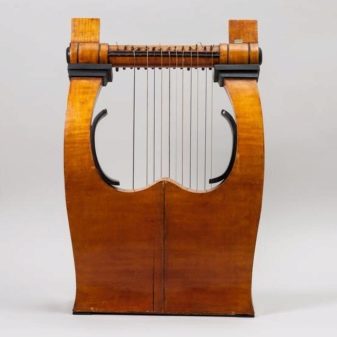

Apollo did not leave unnoticed the theft of his cattle and went to Zeus in order to obtain a just punishment for the criminal. Nevertheless, the god of eloquence Hermes amused Zeus so much with his puns and songs that he decided to peacefully settle the issue in this dispute. The god of heaven and thunder ordered Hermes to return the cattle to the owner, albeit in the form of a string instrument, and to smooth out the conflict, add a herd of divine cows to the return.The patron god of merchants and thieves agreed to such conditions, Apollo was also not against such an outcome of events, because he was fascinated by the sound of the four-string. Thus, theft and deception served as the basis for the creation of a new musical instrument called the cithara.

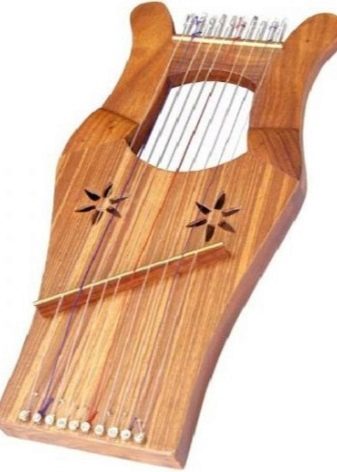
The further fate of the ancient Greek four-string can be learned from the legend of Orpheus and his beloved. Tradition tells that the beautiful bride of Orpheus - a nymph named Eurydice - dies from a snakebite. The grief-stricken widower decides to take a desperate step - he descends into the underworld to persuade the god of the dungeon, Hades, to return his beloved to him. Orpheus chooses cithara as an instrument for such a bold journey, because the instrument was presented to him by the ancient Greek god - Apollo.
Nowadays, a descendant of the cithara, the widely known guitar, is very popular.
Over time, the instrument spread throughout Europe and beyond, but in each country it was called differently: in France, cithara was called "guitar", in Italy - "citarra", and in England - "Hittern".


The very first cithara, which, according to legend, was given to people by the gods, was equipped with only four strings. For ancient Greek musicians, such a structure was quite enough, because at that time there were no complex, multi-level compositions. All the melodies in Ancient Greece were quite light and unpretentious, they were mainly performed as an accompaniment to heroic songs.
The first changes in the design of the cithara were made by a bard named Terpander, who was born in Sparta. The musician added three more strings, which significantly expanded the capabilities of the guitar's predecessor. The talented kifarist with his virtuoso playing managed to calm the rebellious townspeople, which made himself and the musical instrument famous.


The next to complicate the cithara was the musician Frinis from the city of Mytilini - he added more strings, and the total number of them was 10 pieces. It was this design that for a long time was the classic standard in the territory of Ancient Greece.
It is much easier to imagine the life of a particular era if you know what kind of music people preferred then. Due to the traditions of the Greek bards to transmit their creativity orally, most of the creations have disappeared without a trace, but still little information can be obtained from ancient records.
The ancient Greek writer Mestrius Plutarch created a description of several works for the cithara, which have survived to this day. These are the compositions "Hymn to Nemesis", "Hymn to Apollo" and "Epitaph of Seyklos".

In addition, Plutarch worked carefully on the lettering of the notes, thanks to which musicians can now recreate music written in Ancient Greece. Until now, not so many works of ancient Greek kypharists have been preserved, but the musical theory of those times has managed to collect quite a lot. Ancient Greek bards played the cithara using complex patterns and fast and slow transitions. People who study ancient music divide the playing method into three types: Lydian (soft), Dorian (strict) and Phrygian (violent). Each technique is based on a specific sequence of notes, which includes four adjacent keys.


What it is?
Kifara is a musical instrument with a trapezoidal body, two handles and a crossbar that connects them. Outwardly, the ancestor of the guitar looks almost the same as an ordinary lyre. On the cithara, as a rule, there were seven strings of different thickness stretched between the nut on the lower half of the body and the transverse fastening between the handles in the upper part of the instrument. The ancient Greek string-plucked ancestors of guitars were widely used by bards and folk storytellers.
They sang about the exploits of brave people, praising and glorifying their deeds, and also complementing their stories with pleasant musical accompaniment.
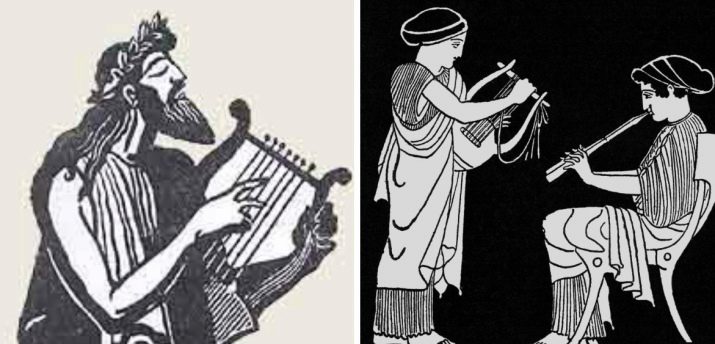
Also, the sound of the four-string always accompanied a variety of rituals and celebrations organized in honor of the ancient Greek gods - the patrons of shepherds, artisans, merchants and farmers. Unfortunately, most of the songs and melodies disappeared without a trace, because they were passed from teacher to student only orally. But still, some very interesting information has been preserved, for example, about the styles of ancient Greek music..
At that time, the kifara was the most popular instrument, and therefore the musicians of those times productively created various directions in music, consider a few of them:
- hymeneos - melodies that were very popular at lavish weddings;
- nomy - most often such songs were performed for theatrical performances, observing the folklore genre of composition;
- peanos - dance songs praising the exploits of the heroes of antiquity;
- kommos - melodies that walking companies most often liked to listen to.


The ancient Greeks were very fond of depicting musicians with citharas on frescoes and amphoras; these pictures have survived to this day and have been carefully studied by researchers. But records of musical compositions and songs practically did not survive - the ancient Greek creators of melodies had a tradition to pass their creativity from mouth to mouth. The cithara was one of the most popular instruments of antiquity, but it was mostly played by men.
The "relative" of the lyre was created from a single piece of wood, so its weight was quite large, but there was also an advantage - the body withstood the load of strong tension of the strings.


In Ancient Greece, they were very fond of the soft, iridescent and like a floating sound of a string instrument presented by God. People at that time believed that cithara compositions restored harmony in a person's soul, and also healed and cleansed his aura. The bards played the four-string while standing, holding it at a slight inclination relative to the body, or sitting, comfortably placing the instrument on their knees. The technique of playing was reminiscent of modern guitar technique - the musicians fingered and plucked the strings with their right hand, and muffled unnecessary notes with their left.
In ancient Greece, the cithara was considered an exquisite and elegant instrument; during the game, the master took more time than any other instrument. Moreover, the professionals who created the ancestor of the guitar had to carefully study everything to the smallest details of the design, because any mistake could ruin the sound of the strings. The ability to play the cithara in Greece was considered an exalted art, the subtleties of which could not be understood by everyone. In ancient times, it was believed that playing a stringed plucked instrument required innate talent, impeccable memory, and strength and dexterity of the fingers.


How is it different from the lyre?
The main difference between these two tools lies in the material of manufacture, we will consider each option in more detail. Lyra in ancient times was made from a tortoise shell or ceramic dishes., on which the skin of livestock was pulled on top of everything else, acting as a membrane. Kifaru was created from a single piece of wood, made in the form of a frame.
In addition, the differences from the lyre were also in the number of strings - if their number on a lyre is strictly established, on a cithara their number can be from 4 to 12 pieces.

Modern kifara
One of the most ancient instruments on our planet has greatly changed over the centuries, also metamorphoses have occurred with the name - gradually the term "kifara" was replaced by "guitar". Moreover, the ancient Greek seven-stringed cithara became the ancestor not only for the guitar, but also for many other modern musical instruments. The "relative" of the lyre became the basis for the creation of a number of musical instruments, such as the domra, balalaika, gusli, zither and lute.












